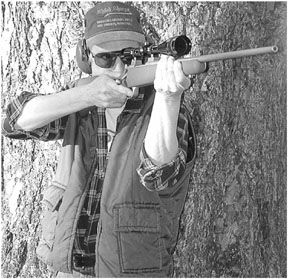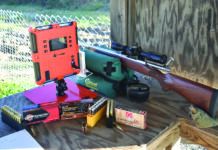
Anyone who has ever gone hunting knows the agony that can come from lugging all one’s gear around for days on end. Along with the rifle, we usually carry water, fire-makings, snacks, and other necessary items in a rucksack. Heavy hunting clothing can add to the burden, and year after year not much of that stuff gets lighter. But one great way to cut down the burden is to pack a lighter rifle, and it’s getting easier every year to get lighter rifles. But what do you give up? With a good rifle, the only sure penalty will be the slightly harder kick, but a good recoil pad takes care of that. Will accuracy be as good? How about holding steady when you’re out of breath? Any other problems?
We decided to find out, and acquired two light .308s, a blued Ruger Model M77CR MKII with walnut stock, called the Compact ($716); and a Kimber Montana 84M with synthetic stock ($1124). We looked at each carefully, scoped ‘em, shot ‘em, and here’s what we found.
[PDFCAP(1)]
We looked through Ruger’s many offerings, including the new forward-scope Frontier and the so-called Ultra-Light, but all of them had suggested weights that were greater than the 5.8 pounds listed for the Compact model. We also checked out the stainless version of the Compact with laminated stock, but it too had a heavier listed weight. When the rifle arrived, its lack of weight was immediately apparent when we took this little number out of the box. The barrel was short and thin, measuring 16.5 inches in length and 0.520-inch diameter at the muzzle. The wood looked great, and showed some fiddleback figure. It was good walnut with a classic shape, excellent finishing and functional checkering. The rifle had Ruger’s perfectly fitted, standard rock-hard recoil pad, something we’ve complained about for a long time. (We have heard recent serious rumors that Ruger will soon do something about these too-hard recoil pads, and we’ll be the first to thank ‘em when the rumors become reality.) We believe you’ll want to change the pad to a good one.
A typical good, classic and classy, blued-steel-and-walnut Ruger rifle, the Compact came with scope rings. The stock had nice figure. To our surprise, the barrel was not free floated. There was a thin gap between the barrel and stock along most of the short forend, detectable only with a slip of paper, but the tip was tight against the barrel for about an inch. The first inch or so of barrel near the action was also tight to the wood. We liked the look of the shortened forend. We don’t believe the Compact is designed to be a youth’s rifle, nor do we think it is one that should be cut down for a youngster. Not only was the pull length adult size at 12.6 inches, this little rifle kicked pretty hard with our test ammo, and that’s not the sort of thing a beginning shooter would appreciate. The rifle weighed just under 6 pounds with the rings, but no scope. Scoped, it tipped the scales at 6.9 pounds.
The bolt was controlled-feed, and ran smoothly in the action. The controls were standard Ruger: three-position safety on the right, bolt release on the left. The bolt and its handle were white; the recoil shield, blued. Bluing on the rifle was glossy and excellent. The floorplate was aluminum, a wise choice, we thought. The trigger guard was steel, another good decision. The magazine held four rounds, and the bolt could be closed over another.
[PDFCAP(2)] we found a tiny bit of creep in the trigger before it broke at 5.25 pounds. We found ourselves wanting the break about a pound or two less as we shot the rifle over our machine rest, and the heavy trigger was more objectionable offhand or from field positions. We installed our 12X Leupold, the big scope dwarfing the little rifle. Something like a 10-ounce, 2.5X or 4X scope would be about right for the rifle, we thought. We tested the rifles with PMC Eldorado ammo loaded with 150-grain Barnes X-Bullets, with Hirtenberger 150-grain soft-nose, and with Winchester Match ammo with 168-grain Nosler match bullets, the latter to see what the rifles would do with some of the finest .308 ammo out there.The Ruger performed perfectly with everything we put through it, getting smoother the more we shot. Also, it seemed to shoot better the more we shot it. Our best groups were with the Match ammo, averaging 1.6 inches, which may or may not be enough accuracy for you, depending on your intended targets with this rifle. We would have liked more, but felt the overall accuracy was adequate for most hunting purposes with a .308.
We already told you recoil was very noticeable with this rifle. Some might have preferred a barrel-mounted forward sling stud. It rammed our hands once or twice. We tried the rifle offhand as well, and found we had a bit of trouble holding steadily because of the light weight and whippy barrel. However, field positions such as kneeling or sitting worked well. But a lighter trigger pull would be a necessity, we thought, for good work with this rifle, along with a good recoil pad.
[PDFCAP(3)]
This rifle felt totally great the second we touched it. We loved the muted look of the gray composite stock and the matching matte-stainless steel. The rifle had an even more balanced feel than the little Ruger, and a longer barrel as well. Kimber reduced the weight everywhere we looked. The magazine was blind, eliminating a floorplate. The bolt was noticeably smaller and much lighter than the Ruger’s. The Kimber action looked like a miniature Model 70 Winchester, but still with controlled feed and all the other attributes that riflemen want, cone-shaped breech and all. The blind magazine held four rounds down, and another in the chamber as required. With the safety in the middle position it was easy and safe to get the unfired rounds out of the rifle.
The gray stock had no checkering. Instead, the surface of the stock was slightly rough all over, which made an excellent substitute for checkering, even when wet. The black recoil pad was a full inch thick (Pachmayr Decelerator) and absorbed recoil well. It also provided a non-slip grip. There were stainless sling studs fore and aft.
The Kimber had a 22-inch mostly free-floated barrel, 0.560-inch diameter at the muzzle, giving it a length advantage of 5.5 inches over the Ruger. We expected the chronograph to show this advantage. The Kimber weighed 5.5 pounds without scope. Pull length was 13.8 inches, longer than the Ruger, yet it fit us all. There was thus less danger of the thumb striking the nose in recoil. The rifle came with extra-cost scope bases, which we feel was the best way to go, because these Kimber bases came with larger-than-normal mounting screws, and those go a long way toward keeping your scope attached over the repeated pounding of many rounds of ammo. Light rifles of reasonable power put a premium on scope mounts because of kick. We obtained some Leupold dovetail-type rings from Brownells (800-741-0015) and used them to mount our 12X Leupold, which brought the overall test weight up to just 6.5 pounds. A more suitable scope would beat that significantly, but we suggest you make sure your scope of choice can be mounted far enough forward to keep it out of your eye, and that the scope also has sufficient eye relief. The 12X bumped our shooting hat more than once.
Our first groups with the delightful Kimber Montana were nothing to rave about. They ran around 1.2 to 1.4 inches. Then we applied Montana X-treme’s 50 BMG cleaner, and used some of the same company’s Bore Cleaning and Polishing Compound, and tried the rifle again. This time we got consistent half-inch groups with the Winchester Match ammo and with the Hirtenberger 150-grain soft nose, and around an inch with the X-Bullets in PMC’s ammo. If in doubt, clean it out.
This rifle had several things that endeared it to us, besides its superlative accuracy. The trigger was outstanding, breaking cleanly at 3.7 pounds. This helped make hits from field positions, in our limited testing, and gave it an edge over the Ruger. The rifle had marvelous balance, better than the fine-handling Ruger, we thought. This again helped the rifleman in the field. The stock was nowhere near as attractive as the Ruger’s walnut, but was probably much stronger. The Kimber’s good recoil pad also was far more to our liking. The only thing anyone might complain about was the price, but compared with the cost of some other semi-custom lightweight rifles, the Kimber is a bargain.
Gun Tests Recommends
• Ruger .308 Compact M77CR MKII, $716. Buy It. All in all, we thought this was an excellent hunting rifle, having all the power of the .308 in a thoroughly portable and well-made package. We’d twiddle the trigger down a pound or so, and put on a decent recoil pad and mount a suitable light, durable scope and call it one of the best light-to-medium power rifles we’ve seen, and one that doesn’t break the bank. For the .308 cartridge, you don’t really need more weight than this one had, though some will argue a heavier rifle will hold steadier. That’s the shooter’s problem, we thought, and with the fine balance of this rifle, not a big one. The owner could also take pride in the rifle’s good looks.
• Kimber .308 Montana 84M, $1124. Our Pick. We found no problems at all with the Kimber. Feeding and ejection were perfect, and the lockwork kept getting smoother the more we shot this fine little rifle. This was one fine little rifle, we thought. If you need a hunting .308 and don’t want to pack anything unnecessary, the Kimber 84M Montana is the rifle for you. Not many rifles of any weight or price will match its accuracy and its features. We believe it’ll satisfy the most picky rifleman. There are other versions available with wood stocks, including the SuperAmerica, but we don’t know if they’ll be as light as this one, and they won’t have stainless metalwork.



























